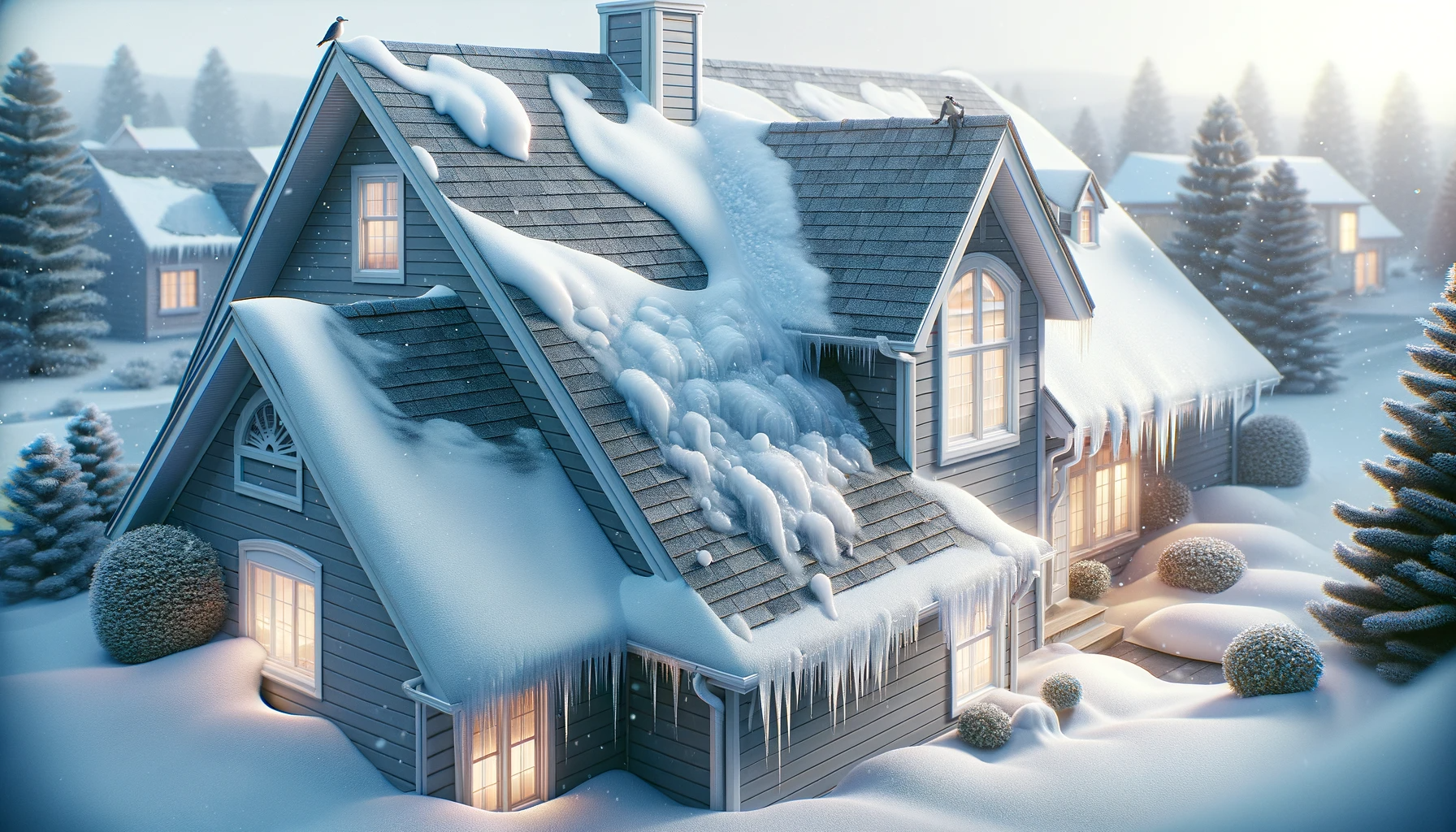In recent years, the unpredictability of winter has become a prevailing theme. The potential for harsh weather to wreak havoc on homes is a constant threat, and the roofs are always the biggest targets. During winter, snow, ice, and relentless winds combine to test the resilience of even the sturdiest roofs. While there are preventative measures to shield your roof from the winter onslaught, surprises can still happen. Hence, in exploring common roofing problems in winter, we’ll navigate the landscape of potential issues and provide insights into ways we can prevent them.
Winter Roofing Issues
-
Ice Dams
Ice dams tend to look beautiful wherever you see them, yet within that picturesque appearance, they are a dangerous winter phenomenon. They pose a common threat that goes unnoticed until the final damage surfaces.
When your roof’s edges appear with a frosty adornment of icicles, it signifies the formation of ice dams. These dams materialize when melted snow refreezes before runoff, thereby resulting in ice accumulation.
The repercussions are far-reaching. They range from dislodging gutters and shingles to infiltrating the home’s structure, fostering mold rot, and necessitating costly repairs.
Preventing ice dams depends on implementing strategic insulation, ventilation, and conscientious gutter maintenance.
You should also be aware that the changing temperature variations are the major culprit behind ice dams. Warm roof sections initiate melting, while colder portions foster freezing. That simple interaction creates the ice dams.
From the above explanation, we can deduce that adequate insulation and well-ventilated attics can minimize the risk of ice dams. However, eliminating it remains elusive.
Regardless, you can use specialized rubber underlayments, like Ice and Watershield, to offer additional protection in vulnerable areas.
-
Condensation
Condensation is typically a minor concern. However, it tends to escalate during winter and poses potential roof issues.
When warm indoor air meets a cold surface, such as the underside of an inadequately insulated attic, condensation thrives. Sadly, the consequences of condensation extend beyond cosmetic concerns.
For instance, excess condensation can cause moisture to accumulate in shingles, thereby accelerating wear and fostering mold and mildew.
Not only do these unwanted guests bring unpleasant odors, but they also usher in a host of health problems.
Preventing winter roofing problems related to condensation requires a two-pronged approach. First, ensure your attic is properly insulated to minimize the temperature difference that triggers condensation.
Second, prioritize adequate ventilation to allow optimal airflow. This will help reduce the likelihood of warm air meeting the cold roof surface.
Undetected condensation can lead to mold, mildew, water stains, wood rot, and electrical issues. As a vigilant homeowner, periodic attic checks for moisture and water damage are key to maintaining a healthy and resilient roof throughout winter.
-
Icicles
As charming as icicles may seem, they tend to harbor potential hazards for homes during winter. These problems are often noticed in association with gutter problems.
If you’re wondering, icicles occur under similar conditions to spawn ice dams. Freezing temperatures and sunlight prompt snowmelt to flow down roofs, and then this melted snow freezes upon reaching the eaves.
Any obstructions in the gutters lead to water overflow. Consequently, the overflow substantially burdens your roofing components and creates perilous icicles.
Beyond posing threats to people and pets, the excessive load jeopardizes roofs and gutters.
Preventing icicles involves vigilant gutter maintenance. Regularly clearing your gutters from debris ensures unobstructed water flow, thereby preventing potential issues.
In any case, we advise that you get professional assistance for thorough gutter upkeep. Those frozen beauties you see may look visually appealing, but you need to approach them cautiously.
Their formation signifies potential danger, with the risk of bodily harm and property damage.
-
Excessive Weight from Ice and Snow
Excessive weight from ice and snow poses a big threat to roofs during winter. These problems usually manifest in potential leaks, ice dams, or, in extreme cases, roof collapse.
Despite the common belief that snow will naturally resolve itself, it can lead to severe damage if left unattended. Homeowners can safeguard against these winter roof problems by understanding their roof’s maximum weight capacity, typically around 20 pounds per square foot for snow.
To calculate the snow load on your roof, simply get a measuring tape and follow use the guide below:
- 10 inches of fresh snow equals 5 lbs per square foot.
- 2 feet of packed snow exceeds 20 pounds per square foot.
- 1 inch of ice is equivalent to one foot of fresh snow.
To prevent potential issues, remove excess snow with a rake or seek professional assistance, especially if signs of damage are detected.
-
Leaks
Roof leaks often trace their origins to vulnerable roof flashing, those slender aluminum components encircling chimneys, vents, pipes, and roof edges. They primarily function as a protective bridge between roofing materials and exposed surfaces.
These flashings play a pivotal role in preventing the intrusion of moisture. During winter, however, these essential elements face heightened susceptibility.
Leaks occur around flashings when the flashings get bent, broken, or removed. These situations compromise their ability to safeguard against water infiltration.
Hence, it is important to regularly conduct a visual inspection for cracks or decay on your roof.
To prevent winter-related flashing leaks, prioritize regular roof reviews, especially before winter’s freeze-thaw cycles.
When flashing becomes outdated, or if they’ve been poorly installed or damaged, they lose their efficacy. It is, therefore, important to monitor them for signs of wear and tear and promptly replace or repair them.
Conclusion
As we navigate the season’s challenges, it is important to get professional assistance. TheRoofPro offers the expertise and commitment to roof health.
We are a reliable partner in safeguarding homes against winter’s trials. Contact us today for expert solutions tailored to your winter roofing needs.


